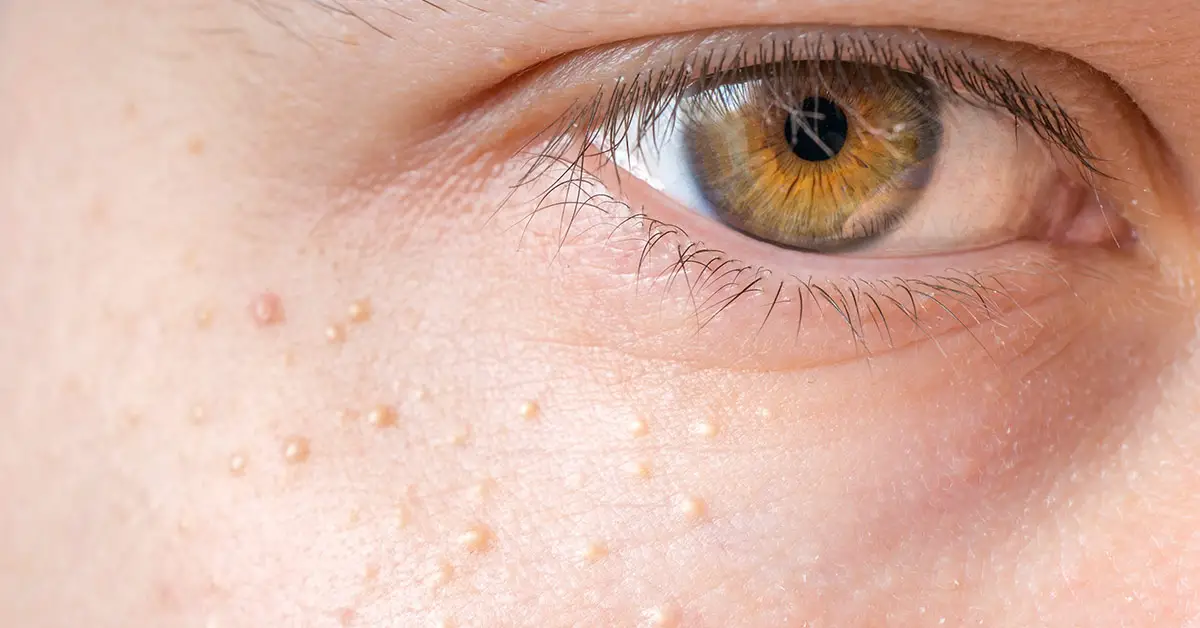Do you have white pimples around your eyes, or have you ever seen another person with them? It turns out these aren’t really acne at all – they’re milia. (1) This is what you should and shouldn’t do to help get rid of them.
Milia: White Pimples Around The Eyes
Milia are little white bumps that appear around the eyes. They are often seen in newborn babies but also are reasonably common in older children and adults. Often, we view them as a type of acne, and our first instinct is to “pop” them. Unfortunately, not only will this not make the milia go away, but it will cause redness, irritation and may even make the problem worse. (2)
Different Types of Milia
Milia are actually teeny, tiny keratin-filled cysts. They can be white or yellow and usually aren’t painful unless they rub or are irritated by clothing. Milia usually appear on the scalp or face, particularly like white pimples around the eyes. They can appear on the arms and legs of newborn babies as well. Usually, they go away in a matter of weeks or months on their own. (1)
There are different kinds of milia, depending largely on the age of the person experiencing them. (2)
Neonatal Milia
This kind, also called primary milia, appears in newborns and goes away after a few weeks. The skin condition is typically seen on the face, scalp, and upper torso. It is relatively common, appearing in around 40% of newborn babies. (1)
Primary Milia in Older Children and Adults
These are the same kind of cysts and can be found around the eyes, on the forehead, and genitalia. They can last from a few weeks to a few months. (2)
Juvenile Milia
Juvenile milia are typically caused by rare genetic disorders. These include (1):
- Bazex-Dupré-Christol syndrome
- Pachyonychia congenita
- Nevoid basal cell carcinoma syndrome (NBCCS)
- Gardner’s syndrome
Milia en Plaque
This type of milia is usually found on the eyelids, ears, cheeks, or jaws and is associated with certain autoimmune skin disorders. These include lichen planus and discoid lupus. These milia tend to be larger in diameter and are seen most often in middle-aged women. (1)
Multiple Eruptive Milia
Multiple eruptive milia are unfortunately one of the types that can be quite itchy. They can appear on the torso, the upper arms, and the face. They don’t typically appear all at once, instead of showing up over a period of a few weeks to a few months. (1)
Traumatic Milia
As the name suggests, this type of milia can occur when the skin is injured. It is seen most often as a result of severe burns or rashes. These cysts are more likely to become irritated. (1)
Milia From Drugs or Products
Some types of creams or ingredients in skincare and makeup can cause milia to appear. It is often seen after long-term or overuse of steroid creams. (1) Other ingredients to watch out for are (1):
- Lanolin
- Liquid paraffin
- Liquid petroleum
- Paraffin oil
- Paraffinum liquidum
- Petrolatum liquid
- Petroleum oil
What Causes Milia?
Scientists and doctors don’t yet know what causes milia in newborns. It is important to note that milia and newborn acne are not the same things. Newborn acne usually appears two to four weeks after birth, triggered by hormones from the mother released during childbirth. (3)
Damage to the skin is the most common cause of milia in older children and adults. This can be blistering from a specific skin condition, sunburns and types of burns, blistering from things like poison ivy, long-term sun damage or steroid cream use, and cosmetic procedures such as dermabrasion or laser resurfacing. (2)
Mili can also be a side effect of aging as the skin loses its ability to naturally exfoliate. (1)
Milia Treatment
As mentioned at the beginning of this article, do not pick, pinch, or squeeze milia. It does not solve the problem and will only lead to scarring and infection. (1)
Typically milia will go away on their own over time. In the meantime, keeping the face or affected area clean with warm water and a mild baby soap or cleanser will help. Be sure to gently rub or pat the skin dry, so you don’t irritate the skin further. (2)
Topical retinoids may be effective against milia, but if the milia are causing discomfort or you simply don’t want to wait for them to go away on their own, there are some dermatological procedures you can have done. (2) These include (1):
- Cryotherapy: Freezing the cysts using liquid nitrogen
- Chemical peels
- Laser ablation
- Diathermy: Using extreme heat to destroy the cysts
- Deroofing: Using a sterile needle to pick out the contents of the cysts
- Destruction curettage: A dermatologist scrapes the cysts and then treats them with heat.
Only licensed dermatologists should perform these procedures.
White Pimples Around The Eyes? Final Verdict
If you have white pimples around the eyes, the chances are it could be milia. It will go away on their own, and they are not a major health concern. If they do not go away after a few months, have your doctor refer you to a dermatologist to make sure they aren’t a sign of another underlying skin issue, or simply to make them go away faster. As always, remember not to touch them too much, and always leave removal procedures to licensed professionals.
Keep Reading: Experts Say Aunts Are Just As Important As Moms When It Comes To Raising Kids
Sources
- “What’s the outlook?” Health Line. Tricia Kinman. June 1, 2018.
- “Milia.” E Medicine. Charles M G Archer, MBBS, MRCP(UK). March 10, 2017.
- “Milia.” Mayo Clinic.

